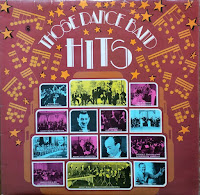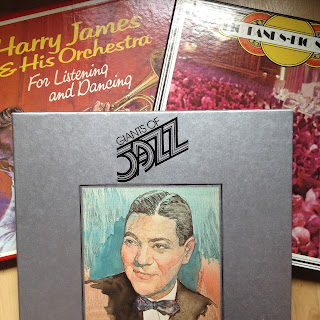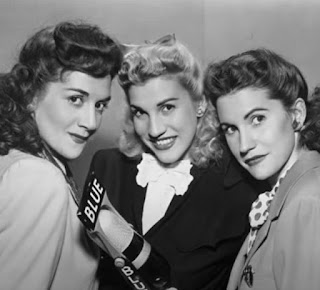After months of spending the majority of my time in my house and home studio I decided to venture out and do some record shopping. Armed with hand sanitizer and a face masked I visited some local used record stores and had some great finds. I'm sure some of this great music will be finding it's way onto Swing City Radio in the next few weeks as I go through the process of converting some of the good tracks over to the mp3 format. I find quite a bit of material so I will probably be presenting my notes in two posts...
Dance to the Bands!:
I have to admit, I'm not the biggest fan of Big Band recordings that were made after 1950. My personal opinion is that the music is usually over produced especially in the 1950's through to the 80's where producers had a love affair for the echo-reverb sound. Don't get me wrong, the music is fantastic. I just prefer the more simple methods of the 1930's and 40's. To me, it helped capture the "feeling" of the music better.
So all that being said, I was impressed with this album. Yes, it has that echo chamber qualities that I'm not a fan of, but the music is very good. The album contains selections from Les Brown, Stan Kenton, Billy May, Harry James, Ray Anthony and Woody Herman. The liner notes on the back cover are fun to read as well. They discuss the trend that was happening at the time of turning your penthouse apartment, suburban living room or college dorm into mini dance halls. Take a look at a picture from the back cover.
(click on image to enlarge)
A Variety of British Dance Band Collections:
As I was browsing through some dusty stacks of vinyl I came across a small collection of records featuring British Dance Bands. As I looked through some of the tracks I noticed that there were more than a few names that I haven't been playing on Swing City Radio. Over the next month or so, I'm sure you'll be hearing more Ray Noble, Jack Hylton, Ambrose, Jack Jackson and Lew Stone of the station.
There are some fun songs on these records. A Great Buy! Plus, some of them contained some nice booklets filled with information.
The Film Tracks of Tommy Dorsey:
This record is horrible. Not because of the content, but because of the recording quality. This was taken from old Radio Remote source copies. I know that these can sometimes be hit or miss, but I dropped the needle on this one and was VERY disappointed. Such great material, but the source copies on these were horrible. And a quick note, I sort through poor quality, old classic radio transcriptions all of the time looking for material for The Big Band and Swing Podcast. But this was sadly unlistenable. If you ever stumble upon this one, just move on.
Dixieland Big Band All Stars:
Now this record is the complete opposite of the Tommy Dorsey record I just describe. This record also features old radio transcriptions from 1949 through 1957. It focuses on a variety of dixieland style radio performances and the music is outstanding. The sound quality is a little dull from time to time but that's to be expected. The original source copies these were taken from were good, so it makes it very enjoyable to listen to. To quickly summarize, this is Dixieland jam session including some of the bigger names of the era. Names like Red Nichols, Jack Teagarden, Jimmy Dorsey, Ziggy Elman, Ben Pollack and more.
This album is a lot of fun. If you enjoy your Big Band and Swing with a side of Dixie, then you'd enjoy this one.
In my next post I'll write about a few other finds I had this past weekend.
Swing City Radio: Playing Your Big Band and Swing Music Favorites from the 1930's, 40's and Today! - Big Band Radio Station Broadcasting Online from King of Prussia, PA.


























